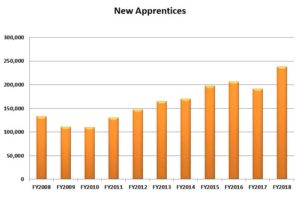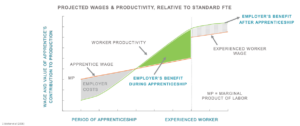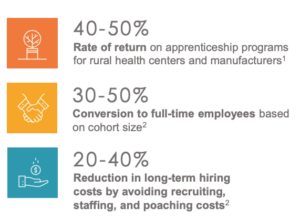How it all began
Last year, PAIRIN was approached by one of our partners, CareerWise, to participate in their apprenticeship program. Because we know how impactful the program is and have more than enough work to go around, we jumped on this opportunity. We decided to hire a Quality Assurance (QA) apprentice to work on our Product Team, reporting to me. After a few calls with several CareerWise team members, I posted the job description and went to their job fair. Over the next few weeks, the resumes poured in.
We used PAIRIN Hiring as the first screening measure which helped us quickly get to the root of who was likely to be a good fit. We based on how well they matched to the Career Readiness Target, which measures Accountability, Initiative, Critical-Thinking and seventeen other attributes foundational to success in the workplace. We also compared them to the PAIRIN Culture Target which is based on a unique set of attributes embodied by our team’s top performers, including attributes such as aestheticism, empathy and stress tolerance.
The applicants we received were incredible. They were captains of international cybersecurity teams, had built their own video games, excelled in music or sports, and nearly all were curious and engaged thinkers. We couldn’t wait to bring one of them on. That is until we realized we were approaching this all wrong.
What IS an apprentice?
Before we can explain how you can avoid making the same mistake we did, it’s important to understand what an apprentice is, and more importantly, what it’s not.
According to the U.S. Dept. of Labor, “Apprenticeships combine paid on-the-job training with classroom instruction to prepare workers [for] highly-skilled careers.” The U.S. has seen a nearly 80% growth over the last ten years in new apprentices.

An apprentice is NOT an intern.
According to Internships.com, “An internship is an official program offered by an employer to potential employees. Interns work either part time or full time at a company for a certain period of time.” They go on to say that interns “have a goal to gain practical work or research related experience.”
Internships tend to be much less structured as there’s no requirement to be a part of a formal program or for in-class instruction. This has contributed to the explosion of internships over the last 30 years. One Forbes article stated that there are over 1.5M interns each year in the U.S. and research done by Time, Inc. indicated 62% of 2017 college graduates held an internship while in school compared to just 17% in 1992. Contrast that to less than 250,000 new apprentices each year, and it’s easy to see that interns have become the standard for temporary and/or student work programs in the eyes of employers. Internships are so widespread that many employers think hiring an apprentice is the same as an intern. It’s not.
Now here’s where we made some mistakes and how you can avoid the same.
We were at a critical staffing inflection point
The trigger to hire an employee is often some felt pain in an organization. As a small or medium-sized organization, bringing on new employees when there is no pain can mean introducing slack. Slack (sometimes referred to as fat) in an organization is often considered a lack of productivity. When managers see their employees without high-priority work to do, this can feel like wasted resources, which usually means wasted money. With the trend toward “lean” or “agile” organizations, stripped of all non-essential activities, slack can be viewed as wasteful. There are some interesting schools of thought that encourage building healthy fat into your work system to help things run more smoothly in the event of a surge or stressor.
In this “lean” culture, the intuitive thing to do is need-based hiring. Our team recognized growing QA needs on the Product Team but not enough work to justify a full-time hire. So, when we had the opportunity to hire an apprentice through CareerWise, it seemed like a natural fit.
I was coordinating QA at the time and knew I could teach a bright high school student to do this part of my job, and they could be a productive employee within a few months. I still believe that to be true. The problem was that I was already at (or above) my total work capacity, therefore, spending the time to train an apprentice and retaining responsibility for QA during their period of learning, meant some other balls would have to drop.
When you have an existing and urgent need, hiring an apprentice is not the right decision. The hiring manager needs to have the capacity to patiently work with the apprentice and help them learn how to do things the right way. If you’re in dire straits, hire someone with experience and expertise for full time or contract support. Then, once your head is above water and you have some healthy slack, invest in an apprentice.
“After an initial training period, businesses usually see a positive return on their investment in an apprentice based on their production,” said Armen Rashidyan, a CareerWise customer success manager. “CareerWise helps businesses develop an infrastructure for training and managing the workload as the apprentice gets up to speed – once they are, apprentices free up time for teams to focus on higher value work.”

We lacked infrastructure
Perhaps, the biggest mistake we made was looking to hire an apprentice even though we didn’t have “in-house expertise.” While apprenticeships include classroom training, having the right infrastructure to help them succeed on the job is crucial. Apprentices are long-term investments who will become increasingly productive.
An apprentice program requires structure and a plan. It’s important to remember that apprentices are students of the trade they are going into, and part of the company’s responsibility in running an apprentice program is being able to give feedback that will steer the apprentice and help them develop the right skillset. Though we have a QA process, it’s a collaborative of product managers, the customer success team and engineers doing work on an as-needed basis. This is a far cry from the robust QA regimen that we aspired to and were seeking, making an apprentice an imperfect fit.
“It’s so important that an apprentice can work with someone who will teach them the tools of the trade and teach them the right way,” says Armen. “Apprentices are potential future employees – one of the primary differences from an internship is that apprentices are being fully prepared to step into full-time roles with a powerful combination of practical work experience, theoretical academics, and your company’s specific culture and methodologies. CareerWise helps with a lot of that structure, but employers should be active participants and have the personnel that intimately understand the position that is being trained for.”

How we’ll do it next time
We plan to participate in the next CareerWise apprenticeship cohort with some slight modifications to our process that we believe will make us and our apprentice successful. We plan to hire in a department and role where we have built-out processes and established manager-employee relationships. We’re ensuring there is enough slack in our system so that our apprentice has room to learn, try, and (most importantly) fail without it putting our business at risk.
We didn’t hire an apprentice this year but we’re putting the structure in place to make it a big success next year. We hope you’ll learn on our dime so that you can benefit from apprenticeships too!
